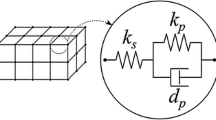Abstract
This paper reports experimental characterisation of a dielectric elastomer which is used as a base material for electro-active polymer actuators and sensors. Specific deformation energy has been experimentally determined to characterise a dielectric acrylic elastomer for large elastic deformation. Specific deformation energy value was estimated from the experimental stress–strain data in the range between zero and chosen strain using trapezoidal method. The coefficients of variation of specific deformation energy measured at different strain values are reasonably low. Results show that specific deformation energy can be better indicator to the differences in large deformations of such material compared to elastic modulus or the slope at the given strain.






Similar content being viewed by others
References
Y.B. Cohen, Electroactive Polymer (EAP) Actuators as Artificial Muscles Reality, Potential and Challenges, 2nd edn. (SPIE press, USA, 2004)
G. Kofod, Dielectric Elastomer Actuator, PhD thesis, Technical University of Denmark, 2001
R. Shankar, T.K. Ghosh, R.J. Spontak, Dielectric elastomers as next-generation polymeric actuators. Soft Matter 3, 1116–1129 (2007)
F. Carpi, D.D. Rossi, R. Kornbluh, R. Pelrine, P. Sommer-Larsen, Dielectric Elastomers as Electromechanical Transducers, 1st edn. (Elsevier Publication, Hungry, 2008)
N.C. Goulbourne, A constitutive model of polyacrylate interpenetrating polymer networks for dielectric elastomers. Int. J. Solids Struct. 48, 1085–1091 (2011)
R. Pelrine, R. Kornbluh, Q. Pei, S. Stanford, S. Oh, J. Eckerle, Dielectric elastomer artificial muscle actuators: towards biometric motion. Smart Struct. Mater. 4695, 126–137 (2002)
R. Pelrine, R. Kornbluh, J.P. Joseph, Electrostriction of polymer dielectrics with compliant electrodes as a means of actuation. Sensors Actuators A 64, 77–85 (1998)
J. Sheng, H. Chen, J. Qiang, B. Li, Y. Wang, Thermal, mechanical and dielectric properties of a dielectric elastomer for actuator applications. J. Mol. Sci. Part B Phys. 51, 2093–2104 (2012)
H.J. Qi, M.C. Boyce, Stress-strain behavior of thermoplastic polyurethanes. Mech. Mater. 37, 817–839 (2005)
J.S. Plante Dielectric Elastomer Actuators for Binary Robotics and Mechatronics, PhD thesis, Massachusetts Institute of Technology, 2006
S. Michel, X.Q. Zhang, M. Wissler, C. Löwe, G. Kovacs, A comparison between silicone and acrylic elastomers as dielectric materials in electroactive polymer actuators. Polym. Int. 59, 391–399 (2009)
M. Wissler, E. Mazza, Mechanical behavior of an acrylic elastomers used in dielectric elastomers actuators. Sensors Actuators A 134, 494–504 (2007)
J.E. Mark, B. Erman, F.R. Eirich, Science and Technology of Rubber, 3rd edn. (Elsevier Academic Press, London, 2005)
C. Harper, Handbook of plastics technologies, 2nd edn. (McGraw-Hill Comp, New York, 2006)
N. Hewitt, PDL Handbook Series: Compounding Precipitated Silica in Elastomers (William Andrew Publishers, New York, 2007)
J. Malac, Elastomers: characterization of tensile behaviour at lower deformations. Polym. Test. 24, 790–792 (2005)
J. Malac, Initial tensile behaviour of elastomers. Polym. Test. 25, 650–655 (2006)
F. Carpi, A. Migliore, G. Serra, D.D. Rossi, Helical dielectric elastomer actuators. Smart Mater. Struct. 14(06), 1210–1216 (2005)
S. Son, N.C. Goulbourne, Finite deformations of tabular dielectric elastomer sensors. J. Intell. Mater. Syst. Struct. 20(18), 2187–2199 (2009)
R.K. Sahu, K. Patra, Estimation of elastic modulus of dielectric elastomer materials using Mooney–Rivlin and Ogden Models. Adv. Mater. Res. 685, 331–335 (2013)
C. Keplinger, T. Li, R. Baumgartner, Z. Suo, S. Bauer, Harnessing snap-through instability in soft dielectrics to achieve giant voltage-triggered deformation. Soft Matter 8, 285–288 (2012)
E. Balagurusamy, Numerical Methods, 6th edn. (Tata McGraw-hill pub. Comp. ltd., New Delhi, 2001)
Author information
Authors and Affiliations
Corresponding author
Rights and permissions
About this article
Cite this article
Sahu, R.K., Patra, K. Characterisation of Tensile Behaviour of a Dielectric Elastomer at Large Deformation. J. Inst. Eng. India Ser. C 95, 207–212 (2014). https://doi.org/10.1007/s40032-014-0119-z
Received:
Accepted:
Published:
Issue Date:
DOI: https://doi.org/10.1007/s40032-014-0119-z




